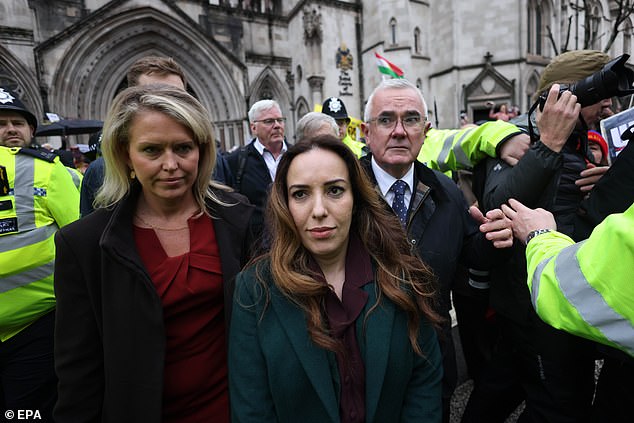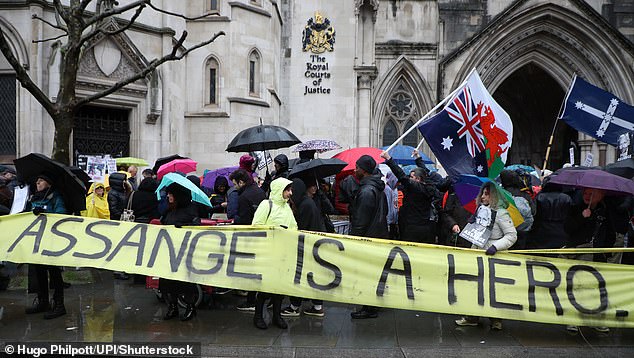Just days from now, Wikileaks boss Julian Assange could be standing shackled on a British airfield preparing to board a plane to the US. Once he disembarks and the sound-proofed door of a supermax prison cell closes behind him, the man who’s made himself America’s most wanted will – finally – be silenced.
Lawyers fear the 52-year-old could be confined alone in a ‘concrete coffin’, a 12ft by 7ft chamber – with a window 3ft high but just four inches wide, designed to ensure that the inmate has no view other than sky or wall. Inside it, his bed, desk and stool will be made of poured concrete too.
Under this regime, meals are passed through a slot in the door and inmates use a stainless steel sink, toilet and shower inside their cell, meaning they don’t even leave to eat or wash.
Once every 24 hours, they are allowed out for an hour to exercise in a small, individually caged space, often sunken, like an empty swimming pool, to prevent them getting any sense of their bearings within the prison complex.


A 2012 class-action lawsuit brought against America’s Federal Bureau of Prisons revealed how a sentence in this sort of facility tests the sanity of the toughest inmates. They ‘interminably wail, scream and bang on the walls of their cells. Some mutilate their bodies with razors, shards of glass, sharpened chicken bones, writing utensils, and whatever other objects they can obtain. A number swallow razor blades, nail clippers, parts of radios and televisions, broken glass, and other dangerous objects’.
Security is, of course paramount. Both prisoners and their cells, which are constantly monitored by CCTV, are searched frequently. Outside, 12ft high walls topped with razor wire, turreted guard towers, floodlights, motion censors and dog patrols mean the likelihood of escape is minute.
Most notorious of all is ADX Florence, an institution in Colorado nicknamed the Alcatraz of the Rockies, which was memorably described by one former warden as ‘a clean version of hell’.
It was the possibility of Assange being entombed there, under what are known as special administrative measures (solitary confinement and the severest restrictions), that temporarily halted his extradition back in 2020.
Now it’s back on and in its endgame following two climactic days of hearings in London’s High Court this week.
Two judges, Dame Victoria Sharpe and Mr Justice Johnson, yesterday reserved their judgment pending further submissions from both sides. They are expected to rule on whether the extradition, originally agreed by former home secretary Priti Patel in 2022, can go ahead, or whether Assange has the right to another appeal, some time next month.

If he loses, his lawyers could try to take his case to the European Court of Human Rights. In theory however, it would be possible for the British Government to facilitate his handover to America before the ECHR is able to order any stay on his extradition.
Assange is wanted in America for trial on 17 charges under the Espionage Act and one of conspiracy to commit computer intrusion for publishing hundreds of thousands of confidential military documents and exposing multiple atrocities committed by American service people during the course of the conflicts in Iraq and Afghanistan.
If convicted, he could face up to 175 years in prison ‘a living death sentence,’ according to his wife Stella, the mother of his two youngest children, Gabriel, six, and Max, five.
‘It would be catastrophic,’ she said yesterday. ‘Our children are British, they are in school, their stability is here. Our contact with Julian would be severely restricted, potentially to one 15-minute call once a month. He would face barbaric conditions even before trial. He will not survive extradition to this kind of torture.’
This is the first time the 1917 Act has been used against a publisher or a journalist, turning the Assange case into a litmus test of press freedom in the 21st century.
The publisher’s supporters also believe it poses serious questions about British sovereignty. His prosecution, they say, is politically motivated, and should not therefore be subject to the terms of the UK-US extradition treaty.
Currently, Britain is only acting as jailer for the Americans, holding Assange in London’s maximum security prison Belmarsh. He was locked up there in 2019 after spending seven years in the Ecuadorian Embassy, where he had been granted asylum by the country’s Left-wing then-president Rafael Correa.
(He entered the embassy in 2012 after being accused of sex crimes, including rape, by two women in Sweden. He denied the allegations and always believed the bid to prosecute him in Stockholm was a part of a US plot to secure an early extradition. Swedish prosecutors dropped the case for the third time in 2019.)
I was the first journalist invited into the embassy for an interview to mark his first 100 days inside. I would return several times over the years and, when Assange and Stella wanted to reveal their engagement and the existence of their two secret sons, they asked me to break the story.

The day I met him in 2012 he was wearing an embroidered Ecuadorian shirt and eating a celebratory lunch of ceviche (raw fish cured by lime juice and chilli) with embassy staff. He likened his life to living in a space station and joked about the bookmaker Paddy Power offering odds of 100-1 on him escaping with a jetpack, like some Bond villain. But his world was already closing in.
By the time I went to see him ahead of the second anniversary of his asylum in 2014, he was clearly finding life harder. He had grown a snowy beard to help people mark the passage of time, he said, but under it he looked pale and weary.
By then his distance vision was failing, he had a chronic lung condition exacerbated by the permanently air conditioned atmosphere, heart problems and soaring blood pressure. He had rigged up a blue sky lamp, which shone on to his ceiling and worked on a timer. ‘Like a battery hen,’ he said. He longed to see sunshine and feel grass under his feet ‘but I can’t even keep a pot plant alive in here’.
When Metropolitan Police officers finally dragged him out in 2019, Assange looked wild-eyed, desperate and dishevelled. The extraordinary TV images which captured the moment were beneficial to the White House and the CIA because they kept the world firmly focussed on one polarising individual, not the principles of free speech and British sovereignty.
He bore little resemblance to the cyber-world superstar who once told me how, in a bid to stop looking so pale beneath his ice-white hair during his embassy appearances, he’d tried to tan his face with a UV lamp. He’d emerged beetroot and had to borrow a female friend’s make-up ‘so that I didn’t look like a Chernobyl victim’, he’d said, laughing at himself and his new and peculiar circumstances.
In Belmarsh, he is locked in a 9 square metre cell for up to 23 hours a day. During one cold snap, he was reduced to boiling his kettle continuously to keep warm. He has been given a ‘computer’ but without internet access and with most of its keyboard glued down. His only interaction with nature has been his practice of feeding breadcrumbs to a pair of mallard ducks nesting beneath his window.
While inside, he’s suffered a stroke and got married to Stella. Apart from that, he might as well have been tasered, he’s been so incapacitated.
During one of our early embassy interviews, I asked him how he would like to be remembered. He said: ‘I wouldn’t. It’s more important to get things done than to be remembered for having done them.’
For the past five years his only achievement has been to survive and now, Stella believes, the next step, extradition, will kill him.
America has countered global fears about inhumane treatment of Assange with diplomatic assurances that he would not be held in ADX Florence or placed in special administrative measures. However, since it caveated this by saying it reserved the right to row back on these assurances in future, the UN’s special rapporteur on torture, Alice Jill Edwards, has joined Stella in speaking out in alarm from Geneva.
There is no arguing with the necessity of an extradition treaty between nations which are allies and friends. But this case is about American hegemony and Wikileaks revealing hundreds of thousands of America’s dirty secrets. As the court heard on Tuesday from Mark Summers KC, the US has a track record of ‘preparedness to use criminal prosecutions as a means of retaliation’.
It was 2010-2011 when Wikileaks released 700,000 documents provided by US defence intelligence analyst Chelsea Manning online. The cache of material exposed war crimes, torture and assassinations, including footage from the gunsight of US Apache helicopter Crazy Horse 1-8 which killed 11 people, civilians and journalists, in Baghdad in July 2007. The kill order heard on camera, ‘Light ‘em all up’, led to carnage and caused global outrage.
The US wants a ‘supervillain’ locked up. But Assange is not the person who committed those crimes and it shouldn’t be him who faces the possibility of life behind bars.
This post was originally published on this site be sure to check out more of their content.








